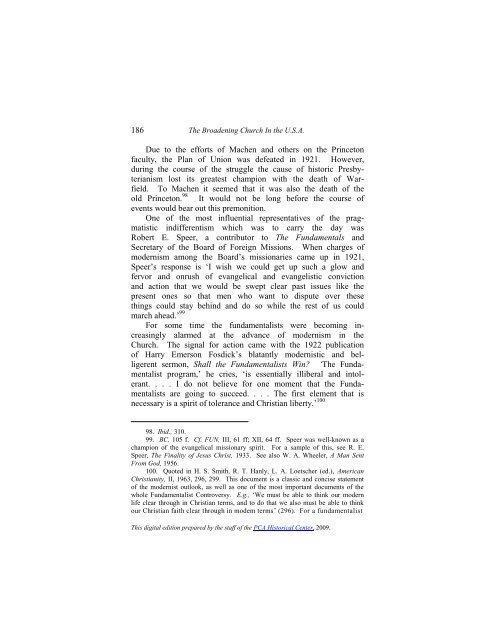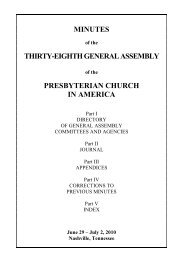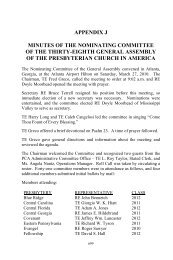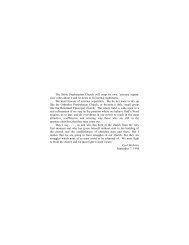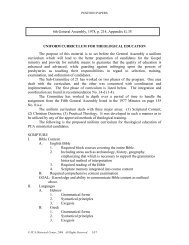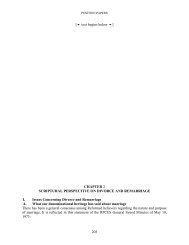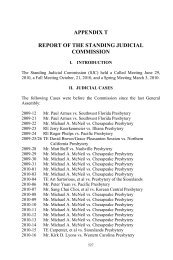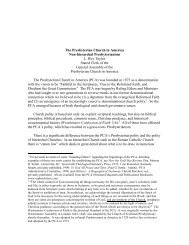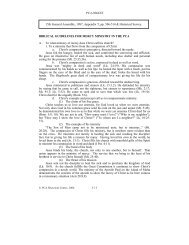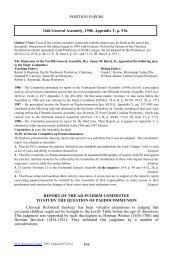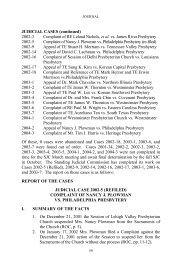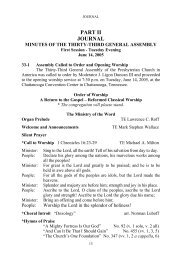Chapter 5: The Broadening Church in the USA - PCA Historical Center
Chapter 5: The Broadening Church in the USA - PCA Historical Center
Chapter 5: The Broadening Church in the USA - PCA Historical Center
Create successful ePaper yourself
Turn your PDF publications into a flip-book with our unique Google optimized e-Paper software.
186 <strong>The</strong> <strong>Broaden<strong>in</strong>g</strong> <strong>Church</strong> In <strong>the</strong> U.S.A.Due to <strong>the</strong> efforts of Machen and o<strong>the</strong>rs on <strong>the</strong> Pr<strong>in</strong>cetonfaculty, <strong>the</strong> Plan of Union was defeated <strong>in</strong> 1921. However,dur<strong>in</strong>g <strong>the</strong> course of <strong>the</strong> struggle <strong>the</strong> cause of historic Presbyterianismlost its greatest champion with <strong>the</strong> death of Warfield.To Machen it seemed that it was also <strong>the</strong> death of <strong>the</strong>old Pr<strong>in</strong>ceton. 98 It would not be long before <strong>the</strong> course ofevents would bear out this premonition.One of <strong>the</strong> most <strong>in</strong>fluential representatives of <strong>the</strong> pragmatistic<strong>in</strong>differentism which was to carry <strong>the</strong> day wasRobert E. Speer, a contributor to <strong>The</strong> Fundamentals andSecretary of <strong>the</strong> Board of Foreign Missions. When charges ofmodernism among <strong>the</strong> Board‟s missionaries came up <strong>in</strong> 1921,Speer‟s response is „I wish we could get up such a glow andfervor and onrush of evangelical and evangelistic convictionand action that we would be swept clear past issues like <strong>the</strong>present ones so that men who want to dispute over <strong>the</strong>seth<strong>in</strong>gs could stay beh<strong>in</strong>d and do so while <strong>the</strong> rest of us couldmarch ahead.‟ 99For some time <strong>the</strong> fundamentalists were becom<strong>in</strong>g <strong>in</strong>creas<strong>in</strong>glyalarmed at <strong>the</strong> advance of modernism <strong>in</strong> <strong>the</strong><strong>Church</strong>. <strong>The</strong> signal for action came with <strong>the</strong> 1922 publicationof Harry Emerson Fosdick‟s blatantly modernistic and belligerentsermon, Shall <strong>the</strong> Fundamentalists W<strong>in</strong>? ‘<strong>The</strong> Fundamentalistprogram,‟ he cries, „is essentially illiberal and <strong>in</strong>tolerant.. . . I do not believe for one moment that <strong>the</strong> Fundamentalistsare go<strong>in</strong>g to succeed. . . . <strong>The</strong> first element that isnecessary is a spirit of tolerance and Christian liberty.‟ 10098. Ibid., 310.99. BC, 105 f. Cf. FUN, III, 61 ff; XII, 64 ff. Speer was well-known as achampion of <strong>the</strong> evangelical missionary spirit. For a sample of this, see R. E.Speer, <strong>The</strong> F<strong>in</strong>ality of Jesus Christ, 1933. See also W. A. Wheeler, A Man SentFrom God, 1956.100. Quoted <strong>in</strong> H. S. Smith, R. T. Hanly, L. A. Loetscher (ed.), AmericanChristianity, II, 1963, 296, 299. This document is a classic and concise statementof <strong>the</strong> modernist outlook, as well as one of <strong>the</strong> most important documents of <strong>the</strong>whole Fundamentalist Controversy. E.g., „We must be able to th<strong>in</strong>k our modernlife clear through <strong>in</strong> Christian terms, and to do that we also must be able to th<strong>in</strong>kour Christian faith clear through <strong>in</strong> modem terms‟ (296). For a fundamentalistThis digital edition prepared by <strong>the</strong> staff of <strong>the</strong> <strong>PCA</strong> <strong>Historical</strong> <strong>Center</strong>, 2009.


